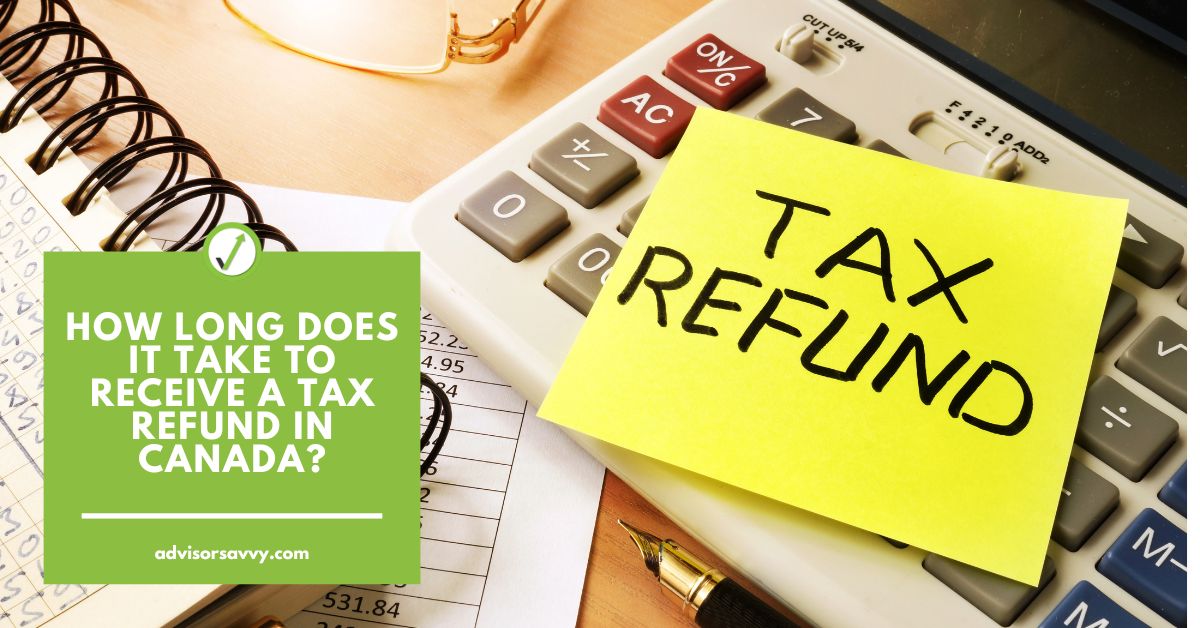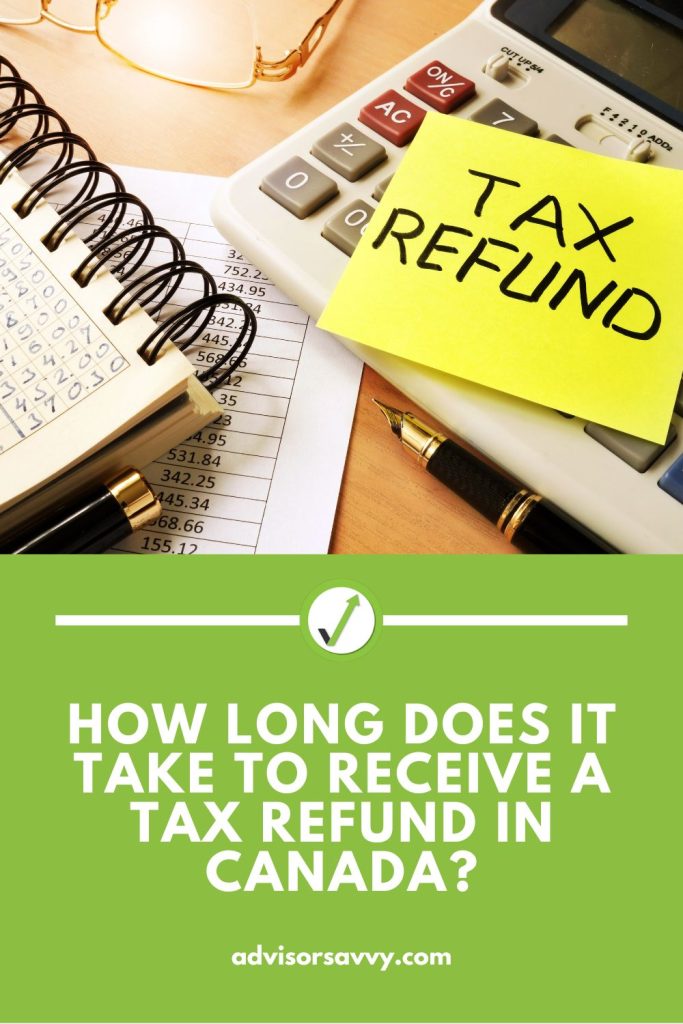
There is often a common question on every taxpayer’s mind. That is — how long does it take to receive a tax refund in Canada? Tax season is generally a stressful time, especially if you have to file your tax returns yourself. If you’re relying on your tax refund to clear up bills or add to savings or investments, you might be pressed to get it into your pocket. At Advisorsavvy, we understand how important it is to get your funds as quickly as possible. In this article, we’ll explore the general timelines surrounding tax refunds in Canada and other helpful details. Keep reading to learn more!

Table of contents
What is a tax refund?
Generally, getting a tax refund in Canada is exciting news. More money coming your way! However, when we refer to a tax refund, it simply means that you paid more tax during the year than you had to. A tax refund is a reimbursement taxpayers get for the excess taxes they pay to the government, usually on employment income. This may happen when too much tax is deducted from your pay cheque. Or you filled out the tax forms related to your payroll incorrectly. Although, sometimes it’s simply because you’re in a lower tax bracket and receive a tax refund as a result.
CIBC Investor’s Line Offer
Up to $6.95 per online stock or ETF trade. Plus, there’s no minimum account balance.
On the other hand, self employed individuals typically owe taxes at the end of the year instead of getting a tax refund. This is because taxes are not deducted off their pay. Rather, their clients pay gross income, not net income as an employer would.
The T1 general tax form is the main document for filing taxes in Canada. It covers everything from net income to taxable income, tax credits to tax deductions. This form also lets you know if you have an outstanding tax balance or if you are eligible for a refund. In other words, individuals use this tax return to calculate their personal tax liability.
Keep in mind, corporations and other legal entities have different tax burdens or refunds and related forms to complete. Sometimes, corporations will receive corporate tax refunds, just like individuals. There is also the Harmonized Sales Tax, or HST refund, which applies in Canada to a multitude of entities, including self employed individuals and corporations. Like other tax refunds, this arises when a person or business has paid more HST than they collected. Here, the government refunds people and businesses for overpaid sales tax.
Some corporations and entities may be eligible for other tax refunds not discussed above. However, these are often specific to their industry or niche. For instance, Canadian charities receive rebates for property taxes and sales taxes to help keep their operating costs low.
How long does it take to receive a tax refund in Canada?
Now that you understand what a tax refund is, it’s time to answer the big question: how long does it take to receive a tax refund in Canada?
First, you must understand that the time it will take depends on many factors. So unfortunately, there isn’t a hard and fast answer. Let’s take the T1 personal tax refunds, for instance. The Canada Revenue Agency (CRA) processes these refunds in two weeks. That is, for applicants who filed electronically and signed up for a direct deposit. But the wait time is different if you filed your application via paper. Also, if you’re not set up for direct deposit, it can take longer to receive a cheque in the mail. In this case, you may wait for about eight weeks or more.
Note that these timelines are broad estimates. The accurate processing time may change, depending on your specific circumstances. This first depends on the volume of applications the CRA has in front of them. Then, other issues may spring up, further extending this time. For example, the CRA labor strike may impact processing times this year compared to previous years.
Ultimately, individual situations can affect tax refund timelines. We advise you to monitor your CRA account for updates. There, you can see the status of your refund. Plus, you will get personalized information relating to its processing.
How long does it take for CRA direct deposit?
How long does it take to receive a tax refund in Canada via direct deposit? As long as you provide a void cheque or your direct deposit details to the CRA, you should receive your payment faster than other methods, such as cheque. On average, you should get your direct deposit payment within five business days of its scheduled date.
If you filed your return by paper but registered for direct deposit, it might take some extra time to receive your tax refund. In addition, other circumstances may affect the processing times. However, direct deposit is the quickest way to receive your refund, so definitely consider registering.
Related Reading: The Best Budgeting Apps and Tools for Canadians
Why tax return is taking so long in Canada?
Before, you had asked, how long does it take to receive a tax refund in Canada? Now, you may want to know why tax refunds are taking so long to process. Perhaps it is taking longer than anticipated based on the information we provided above.
Generally, some common factors affect tax return and refund processing times in Canada. These include the volume of applications the CRA receives during tax season. These can take time to process and review, causing delays. For instance, if you submit your tax return in late April, like nearly everyone else, the CRA will be overloaded with other applications, resulting in delays. If you want to receive your refund faster, consider filing well before the deadline. You can begin the tax return process as early as March 1.
Other issues are incomplete information, errors, and verifications to prevent fraud. There are even instances where applicants may have complex tax situations. For example, where an applicant has multiple income sources, capital gains, and irregular tax credits. These will warrant careful review to ensure accuracy. In some instances, the CRA may contact you to make adjustments prior to processing a tax refund, which takes extra time.
However, these factors are not why tax refunds have taken so long this year specifically. CRA employees went on strike earlier in the 2023 year, which they only called off in May. A spokesperson revealed that those who filed their tax returns on time will soon get their refunds. This applies to those who applied for direct deposit or cheque. But for persons who filed by paper or after May 1, delays are to be expected. This is an expected outcome of the strike, employees are still getting caught up. Experts further predict that the strike will have long-lasting effects.
Do you feel your tax refund delay is connected to the strike action? In that case, the CRA encourages you to visit their website for more information.

Match to your perfect advisor now.
Getting started is easy, fast and free.
How do I track my CRA refund?
Are you wondering: how long does it take to receive a tax refund in Canada? We understand that the estimates provided above may not be enough consolation for you. Rather, you may want to track your CRA refund yourself. Here are some ways to track your CRA refund:
1. CRA “My Account” Service
If you have an account with the CRA, it is the easiest, most reliable way to track your tax refund. Simply log in to your account on the CRA website. Then, scroll to the “View returns and notices” section. There, you will find information on your filed returns. It should also display the status of your pending tax refund. If you don’t have a CRA “MyAccount,” you can sign up here.
2. MyCRA App
The CRA has a “MyCRA” mobile app that allows you to track your tax refunds via your mobile phone or device. This app is similar to your account profile on the CRA portal. The only difference is that this app is adapted for smaller screens. Download the MyCRA app from your device’s app store. Then, follow the prompts to set up and log into your account.
3. TIPS
Another way to track your tax refunds is to call the CRA’s hotline. This is better known as the Tax Information Phone Service (TIPS). Dial 1-800-267-6999 or 1-800-959-1956 and click “Telerefund” when prompted.
Note that you will be asked to provide the following information:
- Your Social Insurance Number (SIN)
- Your year and month of birth
- The total income you provided on line 15000 of your most recent T1 tax refund form
- Your complete address
The phone lines are automated and always open, meaning there are no wait times. But, the CRA encourages applicants to wait at least eight weeks before calling to enquire. You can also visit the Authentication page. Here, you can verify what information you need handy before calling.
CIBC Investor’s Line Offer
Up to $6.95 per online stock or ETF trade. Plus, there’s no minimum account balance.
4. Canadian Non-Residents
If you live outside of Canada, the procedure for tracking your tax refunds is different. First, the CRA expects that you wait at least 16 weeks before inquiring about tax refund delays. After that, you can call the CRA’s International Tax and Non-Resident Enquiries unit. Then, you can ask them any questions about the status of your refund and when you will receive it as a non-resident.
5. Tax Return Software
People often use certain tax software to file their returns. If this is your situation, you can use the software’s refund tracking feature, if they offer it.
Related Reading: Canada Deposit Insurance Corporation
Are tax refunds delayed for 2023 in Canada?
As we said earlier, tax refunds this year faced an unprecedented delay. This resulted from the two weeks’ strike of CRA staff. However, this strike has now been resolved as of May. You can expect to get your tax refunds cleared up soon. To answer the question, yes, some tax refunds are delayed in 2023 due to the strike.
There are some other reasons why tax refunds are delayed in 2023. While the 2022 tax season is over, some taxpayers are facing unpleasant surprises. According to CBC News, the CRA has held on to some people’s tax refunds. These are related to persons that received CERB benefits that they were not eligible for. CERB is short for Canada Emergency Response Benefits. The Canadian government distributed these benefits during the pandemic, however, some abused the system. As a result, the CRA is withholding tax refunds to apply against outstanding CERB debt. The Auditor General revealed that $4.6 billion went to unqualified persons. If your tax refunds are delayed, and you still don’t have answers, this may be the reason. By now, you should have been made aware of your CERB debts considering the CRA has been attempting to collect it since 2021.
If you believe that you were eligible for the CERB benefits, but the CRA disagrees and is attempting to collect the debt using your tax refund, reach out to them directly. It may simply be a miscommunication that is holding up your tax refund.
Tips to Get Your Tax Refund Faster
At this point, we have answered the question: how long does it take to receive a tax refund in Canada? Now, you may also want to know how to get your tax refunds faster in future tax years. Below, we will consider some tips that can help.
1. Stick to Electronic Filing
Filing electronically is the quickest way to file and transmit tax returns. Plus, the CRA typically processes these applications faster since it can be done remotely. You should receive updates on your tax refunds within two weeks.
2. Choose the Direct Deposit Option
When filing your tax returns, select the direct deposit option, not cheque. This ensures that the CRA deposits your tax returns into your bank account. That way, it reduces the time it will take to receive and convert a physical cheque.
3. File Accurate and Complete Tax Returns
Presenting incorrect or faulty information may hold up your tax refunds. A simple error, from missing documents to typos and math errors, can cause problems. But these are avoidable if you cross-check your documents before filing.
4. File Early
The earlier you file your tax returns, the faster the refund can get to you. Late returns typically take longer to process. Save yourself much trouble by filing early. You can begin the process as early as March 1.
Getting Your Tax Refund
In the journey of waiting for your tax refund, time is of the essence. We answered the question: how long does it take to receive a tax refund in Canada? So, follow the tips recommended in this guide, like using electronic filing and direct deposit. We are sure that the guidelines above will help you navigate your tax returns process faster!
Read More: CPP vs OAS: What are the differences?

